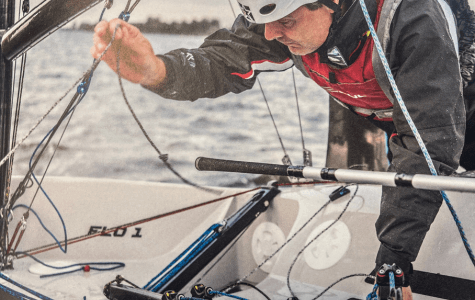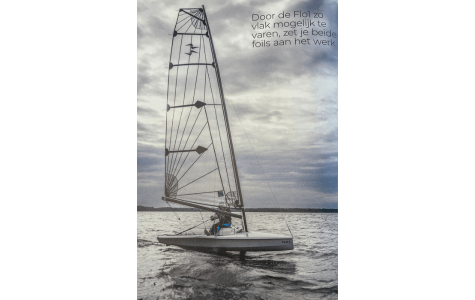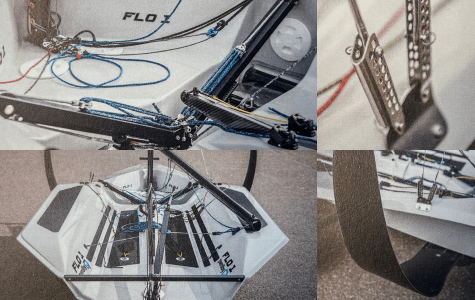Deining Magazine – Wind & foiling experience with the Flo1
Jim Post tested the Flo1 from Aeronamics’ PwrdbyQ for an article in Deining Magazine. Jurian Rademaker, owner of Aeronamics and Qconcepts Design & Engineering, then had a conversation with Jim Post.
The Flo1 is a two-stage rocket, seeming quite formidable. So, we approach it in two steps. The first time, there’s not enough wind; on the retry, it’s a celebration. After motorboat foiling in Deining 06, it was time for more low-flying adventures: sailing while foiling. No throttle, but acrobatics with the mainsheet, the tiller, and the rest of the boat. Doing this 30 years younger on a classic Moth dinghy was manageable, but what about the foiling Moth? With only one main foil amidship plus one steering foil? I probably couldn’t do that in just a few days. This seemingly not-so-unique thought led composite specialist Jurian Rademaker of Aeronamics to a different choice: lowering barriers to make sailing while foiling as easy as possible. He developed this idea: easy foiling, easily transportable, hoisting the sail with a halyard, sailing away from the beach like a dinghy, and lowering the (retractable) foils in sufficient water depth. The result is called The Flo1.
Curved foils
One of the clear choices Rademaker made is based on the arrangement of a table on three legs: stable and no wobbling. The Flo1 developed by Aeronamics is not equipped with a single T-foil amidship but with two foils on the sides. These curved foils are positioned quite forward and do most of the lifting work there. The third ‘’leg’’ is the strut with the foil at the back: for steering and stability. The foils applied on the sides are not T-foils but of the Dynamic Stability System (DSS) type.
Theoretical explanation
During planing and slower sailing, you get crosswise stability from the hull width, aided by your body weight on the extended sides of the hull. As the boat rises, that changes: from now on, the foils dictate the width. The span that arises gives the Flo1 greater crosswise stability than at lower speeds. This foiling stability is also dynamic. As the foils are flowed faster (higher speed), the lift force and thus the stability increase. The heeling moment due to rigging and wind mainly puts the foil on the lee side to work hard. With more wind, more speed, that’s exactly what you want. It may sound like a theoretical story, but practice proves it works. The foils are retractable, and experienced foilers pull the foil to windward when sufficient lift force (higher speed) is achieved. At that moment, you are sailing on two legs. This is for advanced users.
Table
For beginners, the Flo1 is a bit too challenging, but Rademaker indicates that, for example, an average ILCA 7 sailor (Laser) can quickly master the Flo1. I opt for the stable setup, the table on three legs: both main foils plus the steering foil. The daggerboard is added, and after leaving the beach in leeward, all appendages can be lowered as quickly as possible. The lifting foils are equipped with an effective delay for this purpose.
Hanging in
Even though Rademaker states that an experienced foiler can get the boat loose at seven knots of wind, on this first test day I don’t have enough for that, nor is it necessary: I am not an experienced foiler yet. Occasionally foiling a bit and maneuvers not going flawlessly. On the second day, conditions are perfect: wind force four, not below twelve knots of wind, and gusts up to twenty. This turns out to be more than enough to easily lift the hull. It quickly becomes clear that getting loose works best by sailing the Flo1 as flat as possible and thus putting both foils to work. Hanging in. Once enough lift force is built up, we are loose, and my body can rest for a moment. Be alert, stay alert: respond immediately to the rapidly approaching waves and the quickly changing wind angle. The combination of active steering and active sail control proves to be a delightful game once again. Most notably, a lot of power and hard hanging are not necessary during foiling itself.
”By sailing the Flo1 as flat as possible, you put both foils to work.”
Out of the question
Foiling with the Flo1 requires a willingness to learn. For some, this means occasionally letting go of ingrained habits. If you want to foil while beating, start by bearing off generously; pinching is out of the question. With a hefty pull on the mainsheet, you bring the boat up to speed, and once on the foils, you can steer up. Windsurfers are familiar with this game. Also, for the tacking maneuvers, we look at the windsurfers: if you don’t immediately get the hang of the tippy hull, jibing instead of tacking is a good alternative.
Not luffing but bearing off
Even in gusts, you temporarily put aside your possible classic sailing school lessons: not luffing to dump speed but bearing off to accelerate. In the acceleration, the forces in the sail decrease, and the sensation of acceleration can begin. The boat lifts, the rig starts to whistle, and the recesses at the location of the DSS hinge points in the hull sides make suction noises. Time for maximum enjoyment. The acceleration requires quickly pulling in the mainsheet, and the high speed also causes the wind to come relatively forward. Besides pulling in quickly, this also means pulling in strongly.
Fourteen Knots?
How fast does it go? According to Rademaker, a boat speed of twenty knots is very realistic. Even though we don’t reach that today, it’s still quite fast. Rademaker indicates that the hull rises at a boat speed of about seven knots and starts flying at eight knots. Without hard speed measurements, we estimate the transition from foiling to low-flying to be a doubling of the speed during our test day. Whistling fourteen knots, that’s a good start. With the joystick (turning), you can change the position of the steering foil, and as mentioned earlier, you can also sail with only the DSS foil to windward. During tacking maneuvers, that, of course, requires an extra action, also known from the hard work of the America’s Cup professionals. Besides providing a relatively low entry point for the advanced sailor, the Flo1 also offers nuances that the ambitious dinghy sailor is surely looking forward to.
Conclusion
Foiling while sailing sounds like difficult sailing. The Flo1 proves that this is not as difficult as it seems. Ease is the starting point, and careful thought has been given to seemingly peripheral matters such as transport and launching. Once on the water, a top physical condition is not a requirement: as soon as the hull lifts off the water surface, the stability of the Flo1 increases, thanks to the span of the DSS foils.
”Sailing with the Flo1 proves to be a sensation; before you know it, you’re addicted.”
This article is published in Deining Magazine and written by Jim Post. Photography by Maurice Volmeyer.



